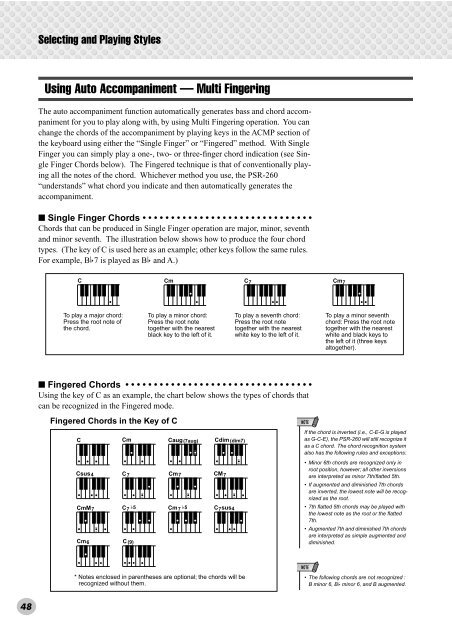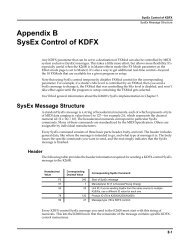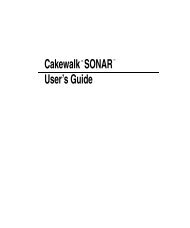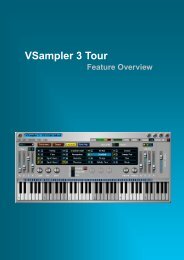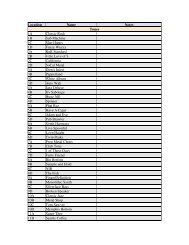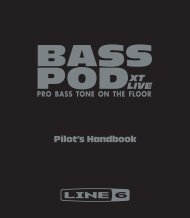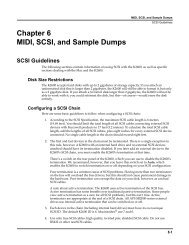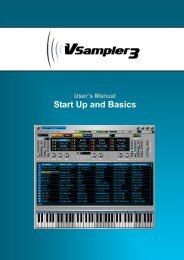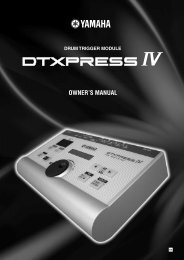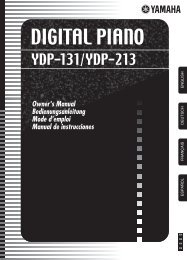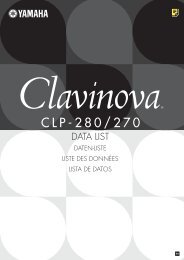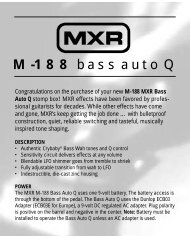2 Change the value. - MIDI Manuals
2 Change the value. - MIDI Manuals
2 Change the value. - MIDI Manuals
You also want an ePaper? Increase the reach of your titles
YUMPU automatically turns print PDFs into web optimized ePapers that Google loves.
Selecting and Playing StylesUsing Auto Accompaniment — Multi FingeringThe auto accompaniment function automatically generates bass and chord accompanimentfor you to play along with, by using Multi Fingering operation. You canchange <strong>the</strong> chords of <strong>the</strong> accompaniment by playing keys in <strong>the</strong> ACMP section of<strong>the</strong> keyboard using ei<strong>the</strong>r <strong>the</strong> “Single Finger” or “Fingered” method. With SingleFinger you can simply play a one-, two- or three-finger chord indication (see SingleFinger Chords below). The Fingered technique is that of conventionally playingall <strong>the</strong> notes of <strong>the</strong> chord. Whichever method you use, <strong>the</strong> PSR-260“understands” what chord you indicate and <strong>the</strong>n automatically generates <strong>the</strong>accompaniment.■ Single Finger Chords • • • • • • • • • • • • • • • • • • • • • • • • • • • • • •Chords that can be produced in Single Finger operation are major, minor, seventhand minor seventh. The illustration below shows how to produce <strong>the</strong> four chordtypes. (The key of C is used here as an example; o<strong>the</strong>r keys follow <strong>the</strong> same rules.For example, Bb7 is played as Bb and A.)C Cm C 7 Cm 7To play a major chord:Press <strong>the</strong> root note of<strong>the</strong> chord.To play a minor chord:Press <strong>the</strong> root notetoge<strong>the</strong>r with <strong>the</strong> nearestblack key to <strong>the</strong> left of it.To play a seventh chord:Press <strong>the</strong> root notetoge<strong>the</strong>r with <strong>the</strong> nearestwhite key to <strong>the</strong> left of it.To play a minor seventhchord: Press <strong>the</strong> root notetoge<strong>the</strong>r with <strong>the</strong> nearestwhite and black keys to<strong>the</strong> left of it (three keysaltoge<strong>the</strong>r).■ Fingered Chords • • • • • • • • • • • • • • • • • • • • • • • • • • • • • • • • •Using <strong>the</strong> key of C as an example, <strong>the</strong> chart below shows <strong>the</strong> types of chords thatcan be recognized in <strong>the</strong> Fingered mode.Fingered Chords in <strong>the</strong> Key of CCCmCaug(7aug)Csus 4 C 7CmM 7 C7b5Cm7b5( )Cm 6Cm 7C (9)( )( )( )Cdim (dim7)CM7( )C sus 4 7( )If <strong>the</strong> chord is inverted (i.e., C-E-G is playedas G-C-E), <strong>the</strong> PSR-260 will still recognize itas a C chord. The chord recognition systemalso has <strong>the</strong> following rules and exceptions:• Minor 6th chords are recognized only inroot position, however; all o<strong>the</strong>r inversionsare interpreted as minor 7th/flatted 5th.• If augmented and diminished 7th chordsare inverted, <strong>the</strong> lowest note will be recognizedas <strong>the</strong> root.• 7th flatted 5th chords may be played with<strong>the</strong> lowest note as <strong>the</strong> root or <strong>the</strong> flatted7th.• Augmented 7th and diminished 7th chordsare interpreted as simple augmented anddiminished.* Notes enclosed in paren<strong>the</strong>ses are optional; <strong>the</strong> chords will berecognized without <strong>the</strong>m.• The following chords are not recognized :B minor 6, Bb minor 6, and B augmented.48


